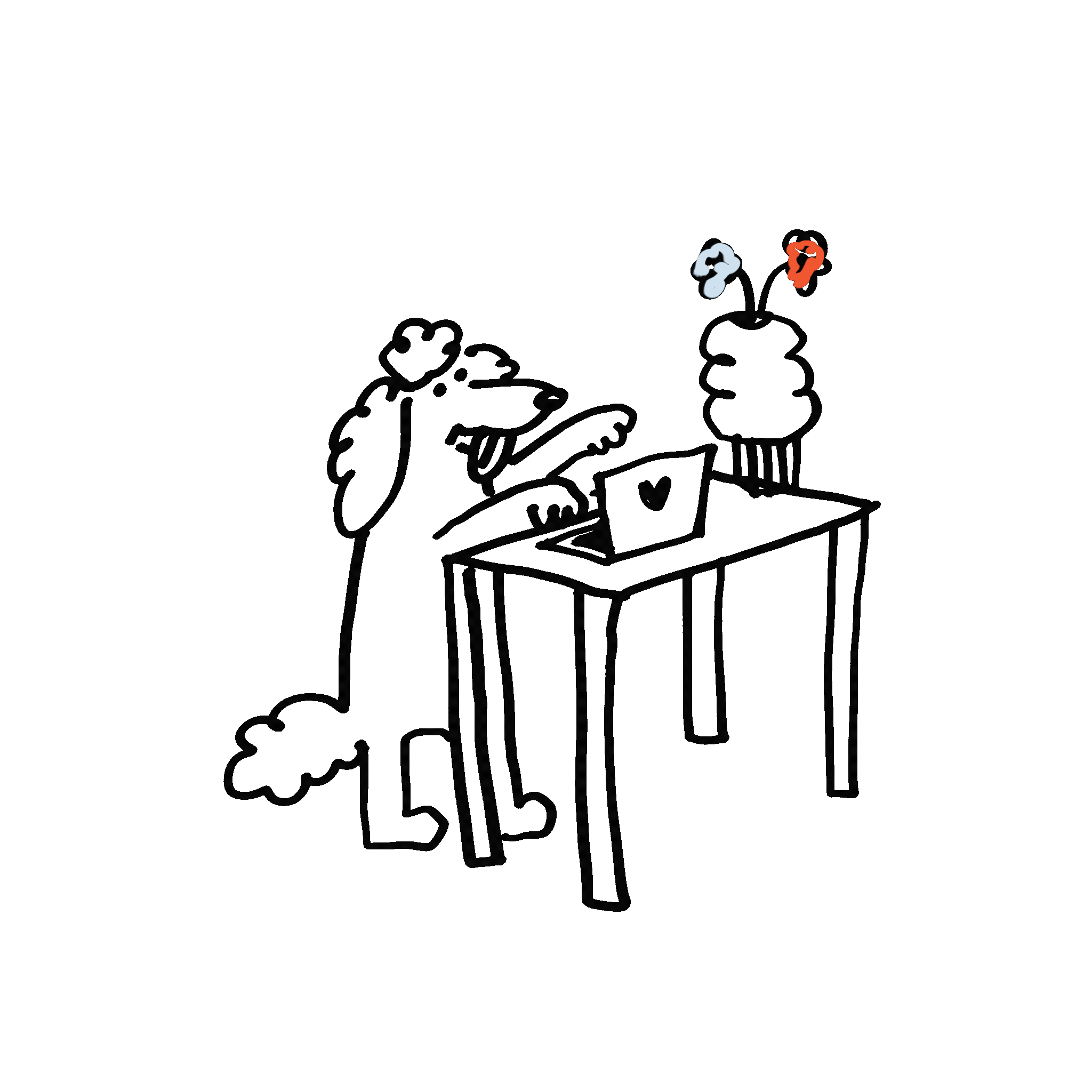Our goal was to improve the new mother experience.
🫂 Human-Centered Design. 👩🏻🏫 Instructional Design. 🌲 Dartmouth College.
Motherhood is Hard. New mothers are bombarded with tons of conflicting information, struggle with isolation, and feel self-doubt.
Introduction
I worked on this hefty project with three teammates, Nitasha Kochar, David Ruiz, and Angela Zhang over 6 months for a social impact design course. The Women's Health Resource Center (WHRC) approached us with a request: can we improve the new mother experience?
Together, we attended programs at the WHRC and interviewed dozens of new mothers, WHRC coordinators, instructional designers, and medical and maternity professionals; coordinated with community resources, and created a three-pronged solution that has since been implemented.

Our Solutions
After three months of need-finding, user research, interviews, and planning, we implemented three solutions: the 5th Trimester Group (a monthly group that provides a social space for new mothers with babies that are older than 6 months), Taking Care of Baby & Mommy (a heavily revised WHRC course with added topics in parental self-care), and a Community Partnerships program (an accessible support network between local businesses and the WHRC).
User Research
The WHRC initially approached us with an idea for an app that concisely delivered vital information to new parents. We began our discovery by interviewing new mothers (and their babies, but they didn't say much), WHRC staff, pediatricians, and many other experts. From our ethnographic research, we summarized our findings with user personas and empathy maps.
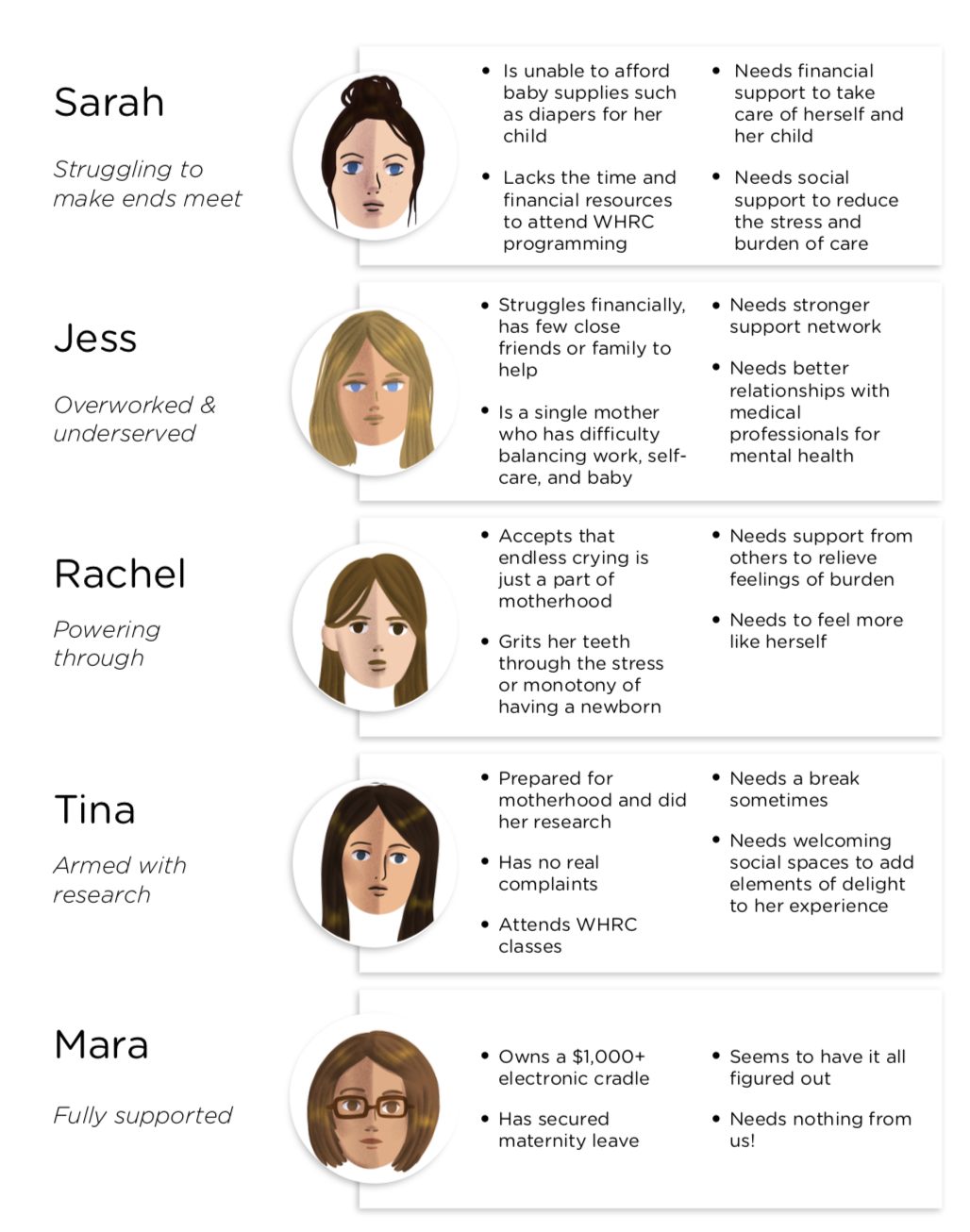
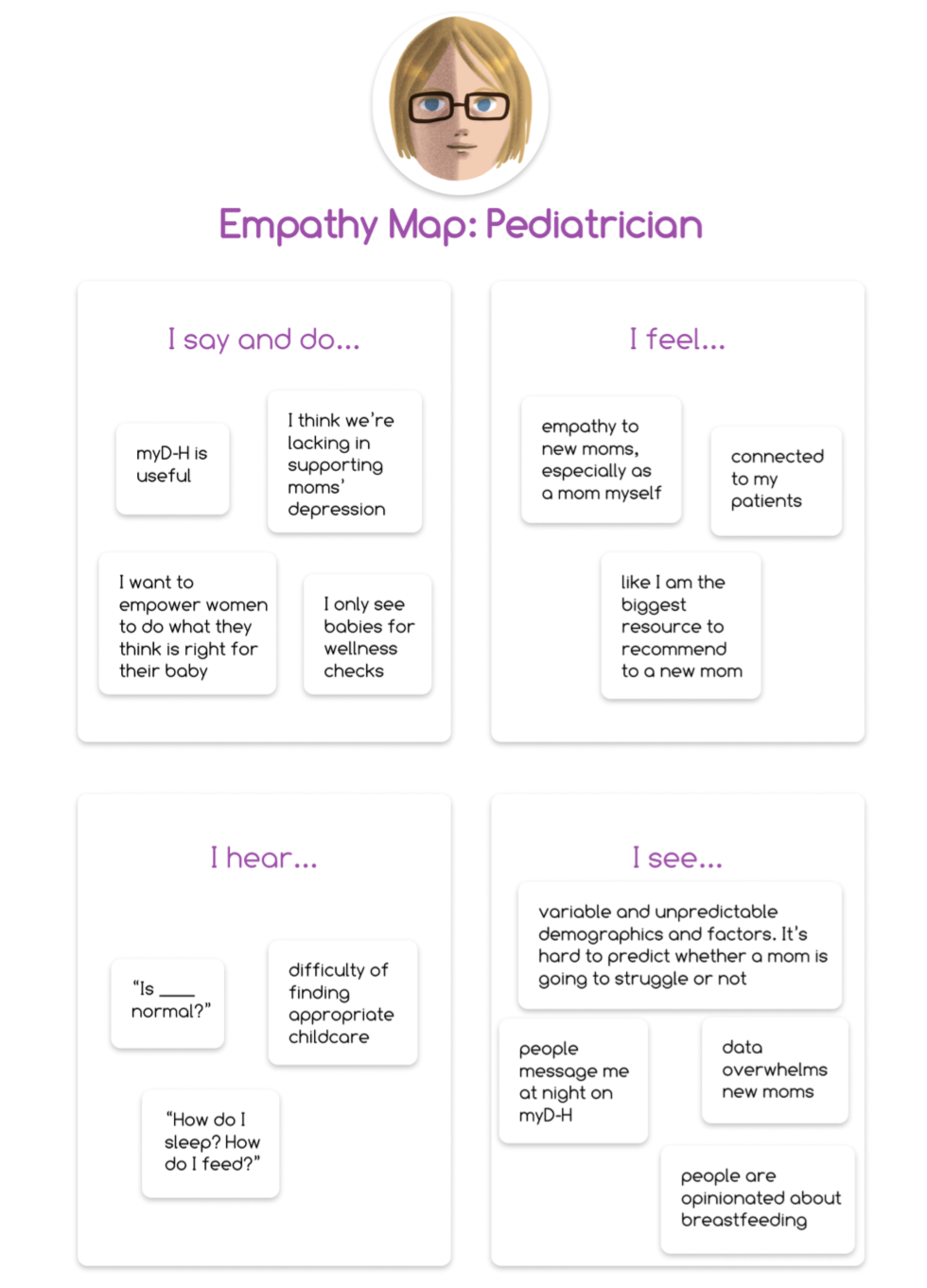
From our research, we gleaned these 5 insights:
- Moms receive too much data.
- The WHRC needs onboarding materials.
- New moms do not need another app.
- New mom self-care is neglected.
- New moms feel isolated and feel excessive self-doubt.
To read more about how we reached these insights, please check out this section of our project summary.
Interestingly enough, we found that new mothers were not only averse to increasing their screentime, but many of their needs were not met by current resources. We then revised our need statement away from creating a guide or app and toward meeting new mothers where they were. Bright spots included peer-to-peer support groups, but they only included mothers with children from age 0 to 6 – and even then, mothers with multiple children found it difficult to attend these group sessions because their resources were spread thin.
Our solution needs to empower mothers to feel confident in their decisions, emphasize self-care, establish peer-to-peer support, be financially accessible, and welcome mothers with children over the age of 6 months and multiple children.
Prototyping & Iterating
Based on our interviews and observations, our solution must:
- Empower mothers
- Emphasize self-care
- Establish peer- to-peer support
- Be accessible.
Creating a robust social app was not within the budget for WHRC, so we decided to improve access to community resources. Prototyping was fun, engaging, and rewarding. We had initially decided on creating a new course, Taking Care of Mommy, and redesigning a course they already had called Taking Care of Baby. Based on our user interviews and research, we found that mothers with children over the page of 6 months found it next to impossible to form and maintain connections with other mothers. Moreover, mothers also struggled with the inaccessibility of bringing a newborn to public spaces.
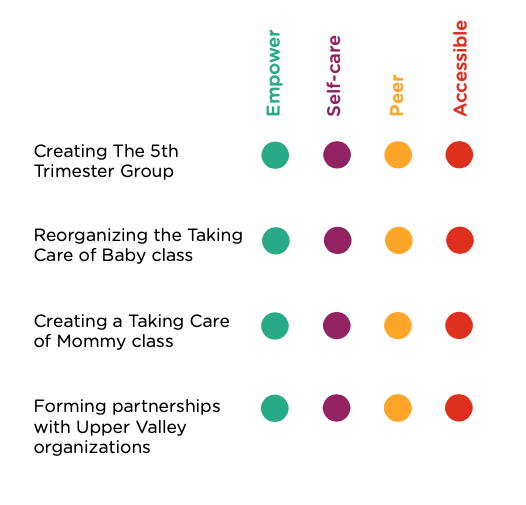
We piloted our 5th Trimester program and learned that the group should be open to all parents, and not just mothers. We broadened our target users to be any parent with a child over the age of 6 months and implemented guidelines to ensure that children would remain safe when mingling. Ironically, we also discovered that the group should not be too structured to ensure a supportive and social atmosphere, rather than that of an informative class. Please feel free to read more about the 5th Trimester program.
At the same time, we developed partnerships with local community businesses to curate family-friendly programming. These events will not only present mothers with opportunities to get out of the house and enjoy themselves, but also provide them with a space to meet other moms, ask questions, and foster intra-community relationships – like this event we hosted with King Arthur Flour and a local recreational area for free for new parents. Our events were successful because they were delightful and financially accessible. You can also read more about our project report section about our community partnerships.
After attending WHRC courses and interviewing mothers who attended, we found that courses could do much more to equip mothers with the tools to take better care of themselves physically, mentally, and emotionally. There was no space to discuss the harsher realities of motherhood, like pain management and body image. Moreover, facilitators for these courses would change often, and there did not exist a set onboarding process. We met with WHRC facilitators, a CenteringPregnancy trainer (CenteringPregnancy was a bright spot – a place for mothers to connect with other mothers, if they had the resources and time to attend the course), and instructional designers at Dartmouth to redesign the courses. You can also read more about Taking Care of Mommy/Baby here.
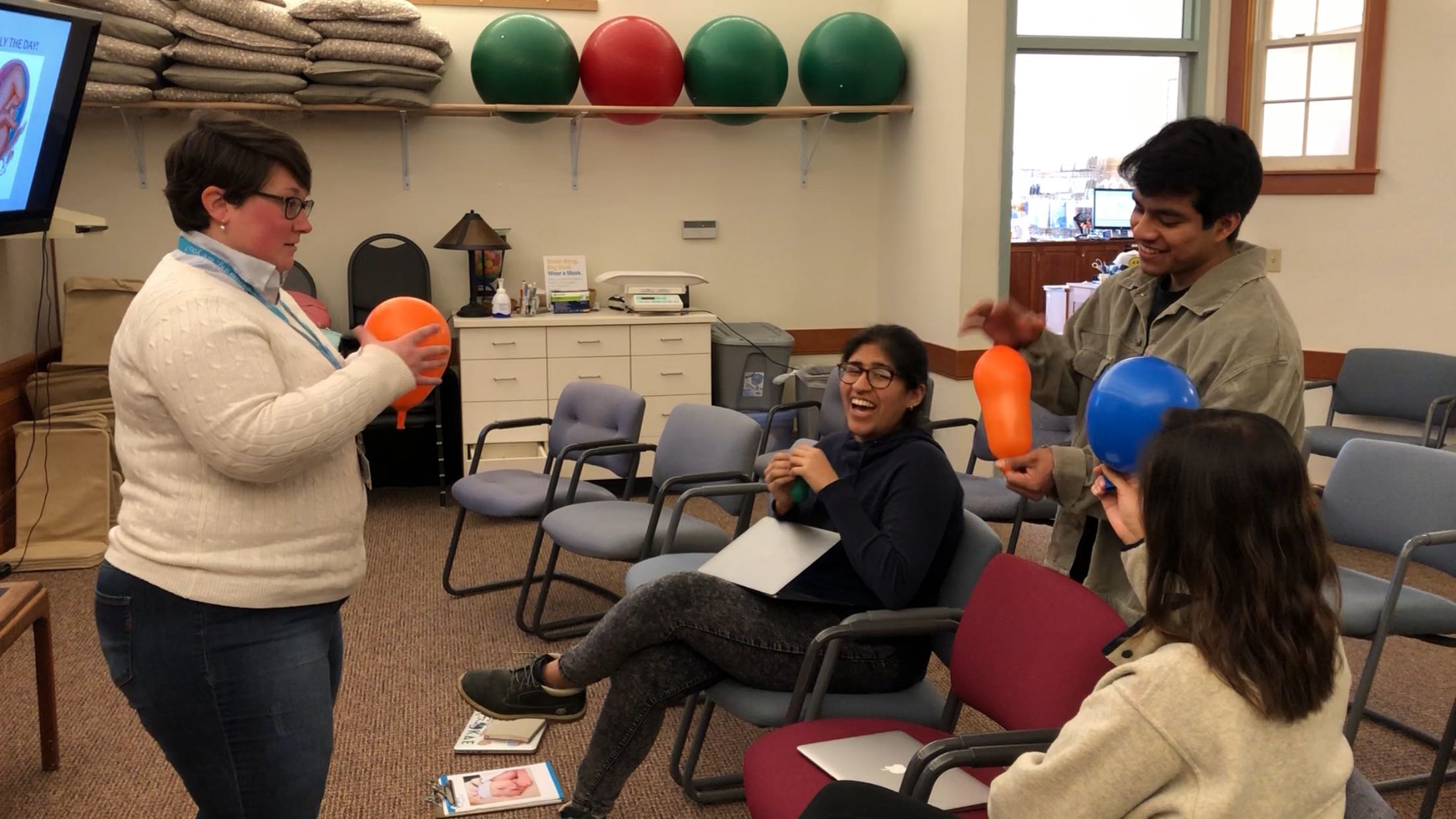
Conclusion
We are extremely thankful to have had the opportunity to work with the Women’s Health Resource Center. Over these six months, we have learned about the nuances of motherhood by speaking with experts, designed and ran programs, events, and activities, and addressed the needs that we uncovered through numerous interviews. We also met incredible women, supportive partners, and adorable babies. The dedication and support from our team, peers, and stakeholders have taught us how to be better collaborators, listeners, and designers. We hope that our solutions can help the WHRC continue to empower new mothers and provide them with a greater sense of community and support.
As for what I learned and did personally, I have a few reflections:
- Team role: I was a collaborator and communicator – I did my best to make late-night work sessions fun, threw in wild-card ideas to get brain juices flowing, and generally was enthusiastic and empathetic towards my teammates.
- Design process: I spearheaded the Taking Care of Baby/Mommy part of our solution because I'm passionate about teaching and instructional design. I created many of our assets, because I was skilled in Figma, Photoshop, and other programs and platforms.
- Nothing is obvious: Once we synthesized our insights, it's easy to say "Duh! Of course mothers need emotional support!" However, I learned that "obvious" insights might be obvious because people overlook them and consider them to be norms. We want to overturn harmful norms. To understand the root that norm, so we have to go into the design process with no assumptions, dig a little deeper, and embrace the obvious.
Connect with me!
If you're a student who wants to know more about product design, a small team looking for a freelancer, or just another poodle-owner, hit me up on Linkedin or shoot me an email at theia.y.qu@gmail.com.
